nursing management
Alliant International University
Page 4 out of 38 results
Sort by
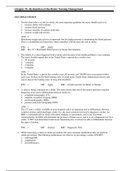
-
Chapter 35--Dysfunction of the Brain: Nursing Management
- Exam (elaborations) • 6 pages • 2020
-
- $3.99
- + learn more
Chapter 35--Dysfunction of the Brain: Nursing Management MULTIPLE CHOICE 1. For the client who is at risk for stroke, the most important guideline the nurse should teach is to: 1. increase drinks with caffeine. 2. monitor blood pressure. 3. increase amounts of sodium in the diet. 4. monitor weight and activity. PTS: 1 DIF: Apply REF: Box 35-1 Modifiable Risk Factors for Stroke Development 2. The family of a client diagnosed with a stroke asks the nurse if this health problem is very co...
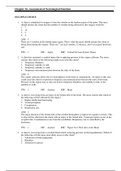
-
Chapter 34--Assessment of Neurological Function
- Exam (elaborations) • 6 pages • 2020
-
- $3.99
- + learn more
Chapter 34--Assessment of Neurological Function MULTIPLE CHOICE 1. A client is scheduled for surgery to fuse the vertebra in the lumbar region of the spine. The nurse should instruct the client that the number of vertebra being affected by this surgery would be: 1. 7. 2. 12. 3. 5. 4. 4. PTS: 1 DIF: Apply REF: Central Nervous System: Bones 2. A client has sustained a cerebral injury that is applying pressure to the corpus callosum. The nurse realizes that which of the following might occ...
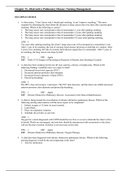
-
Chapter 33--Obstructive Pulmonary Disease: Nursing Management
- Exam (elaborations) • 6 pages • 2020
-
- $3.99
- + learn more
Chapter 33--Obstructive Pulmonary Disease: Nursing Management MULTIPLE CHOICE 1. A client states, “I don’t know why I should quit smoking. It can’t improve anything.” The nurse responds by informing the client about the decrease in lung cancer rates over time after a person quits smoking. Which of the following is correct? 1. The lung cancer rate corresponds to that of nonsmokers 1 year after quitting smoking. 2. The lung cancer rate corresponds to that of nonsmokers 2 years after qui...
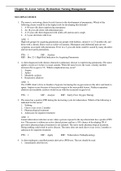
-
Chapter 32--Lower Airway Dysfunction: Nursing Management
- Exam (elaborations) • 6 pages • 2020
-
- $3.99
- + learn more
Chapter 32--Lower Airway Dysfunction: Nursing Management MULTIPLE CHOICE 1. The nurse is reviewing clients for risk factors in the development of pneumonia. Which of the following clients would be at the highest risk for developing this disorder? 1. A 48-year-old client experiencing menopause 2. An 18-year-old client with abdominal pain 3. A 23-year-old client diagnosed with sickle-cell anemia and a cough 4. A 3-year-old client with fever PTS: 1 DIF: Analyze REF: Box 32-1 High-Risk Indic...
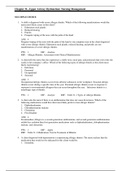
-
Chapter 31--Upper Airway Dysfunction: Nursing Management
- Exam (elaborations) • 6 pages • 2020
-
- $3.99
- + learn more
Chapter 31--Upper Airway Dysfunction: Nursing Management MULTIPLE CHOICE 1. A child is diagnosed with severe allergic rhinitis. Which of the following manifestations would the nurse most likely assess in this client? 1. Edematous neck glands 2. Reduced hearing 3. Pruritis 4. Frequent wiping of the nose with the palm of the hand PTS: 1 DIF: Analyze REF: Allergic Rhinitis: Assessment with Clinical Manifestations 2. A client tells the nurse that she experiences a stuffy nose, nasal pain,...
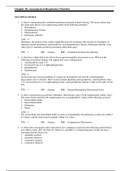
-
Chapter 30--Assessment of Respiratory Function
- Exam (elaborations) • 5 pages • 2020
-
- $3.99
- + learn more
Chapter 30--Assessment of Respiratory Function MULTIPLE CHOICE 1. A client is experiencing the ventilation-perfusion mismatch termed shunting. The nurse realizes that the client most likely is not experiencing which of the following disorders? 1. Hemothorax 2. Intrapulmonary fistulas 3. Pneumothorax 4. Pulmonary embolus PTS: 1 DIF: Analyze REF: Ventilation-Perfusion Dysfunction 2. A client has a slight shift to the left on the oxygen-hemoglobin dissociation curve. Which of the following ...
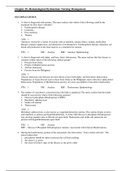
-
Chapter 29--Hematological Dysfunction
- Exam (elaborations) • 6 pages • 2020
-
- $3.99
- + learn more
Chapter 29--Hematological Dysfunction: Nursing Management MULTIPLE CHOICE 1. A client is diagnosed with anemia. The nurse realizes that which of the following could be the treatment for this client’s disorder? 1. Erythropoietin therapy 2. Leukemia 3. Poor nutrition 4. Trauma PTS: 1 DIF: Analyze REF: Anemias: Epidemiology 2. A client is diagnosed with alpha- and beta- defect thalassemia. The nurse realizes that this disease is common within which of the following cultural groups? 1. Pe...
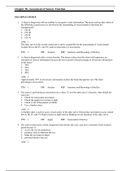
-
Chapter 38--Assessment of Sensory Function
- Exam (elaborations) • 5 pages • 2020
-
- $3.99
- + learn more
Chapter 38--Assessment of Sensory Function MULTIPLE CHOICE 1. A client is diagnosed with an inability to recognize visual information. The nurse realizes that which of the following cranial nerves is involved in the transmitting of visual stimuli to the brain for interpretation? 1. CN II 2. CN III 3. CN IV 4. CN VI PTS: 1 DIF: Analyze REF: Anatomy and Physiology of the Eye 2. A client is diagnosed with a vision disorder. The nurse realizes that the client will experience an alteration in...

Do you wonder why so many students wear nice clothes, have money to spare and enjoy tons of free time? Well, they sell on Stuvia! Imagine your study notes being downloaded a dozen times for $15 each. Every. Single. Day. Discover all about earning on Stuvia


